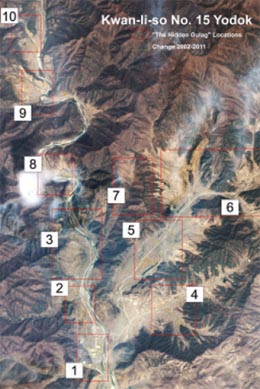New images of North’s prison camps

A satellite photo taken on April 7, 2011 and released yesterday by Amnesty International shows Political Prison Camp 15 in central North Korea. [YONHAP]
North Korean political prison camps have been notorious for torturing and starving prisoners, which often leads to death. The new imagery shows the location and size of the camps, demonstrating a “significant increase” compared to satellite images of the camps from 2001.
“As North Korea seems to be moving towards a new leader in Kim Jong-un and a period of political instability, the big worry is that the prison camps appear to be growing in size,” said Sam Zarifi, Amnesty International Asia Pacific director. “These are places out of sight of the rest of the world, where almost the entire range of human rights protections that international law has tried to set up for the last 60 years are ignored.”
Amnesty International’s satellite images showed four of the six concentration camps in North Korea, located in the countryside in South Pyongan, South Hamgyong and North Hamgyong provinces.
The human rights group also released statements from former inmates and camp guards, including from the Yodok Kwanliso No. 15 camp in South Hamgyong. Many who are incarcerated usually do not know what they were convicted of and many witness deaths and murders within the camps, which are believed to have been in operation since the 1950s, Amnesty International said.
Political prisoners are usually divided into two groups: those placed in “total-control zones” and others placed in “revolutionary zones.” Being placed in a total-control zone indicates a life sentence, while those in revolutionary zones can expect to be released at some point.
“Everyone in Kwanliso witnessed executions,” Amnesty International cited a former inmate surnamed Kim as saying.
Said Zarifi: “Hundreds of thousands of people exist with virtually no rights, treated essentially as slaves, in some of the worst circumstances we’ve documented in the last 50 years. Conditions in these camps are inhuman and Kim Jong-il must close them immediately.”
By Christine Kim [christine.kim@joongang.co.kr]
한글 관련 기사 [중앙일보]
“북 정치범 수용소 확장…20만 명으로 늘어”
북한 정치범 수용소의 규모가 10년 전보다 크게 커진 것으로 나타났다고 국제인권단체인 앰네스티 인터내셔널(AI)이 3일(현지시간) 밝혔다. 이 단체는 현재의 수용자 수를 약 20만 명으로 추정했다. 한국 정부 당국자는 북한의 정치범 수용소에는 15만4000명가량이 갇혀 있는 것으로 파악됐다고 지난 1월 밝혔다.
영국 런던에 본부를 둔 AI는 이날 인터넷 홈페이지를 통해 북한 정치범 수용소 실태에 대한 보고서와 두 장의 위성사진을 공개했다. 하나는 흔히 요덕수용소로 불리는 함경남도 요덕의 15호 관리소와 주변 지역(사진 위)을 포착한 것이었다. AI는 10년 전의 위성사진(사진 아래)과 비교했을 때 건물이 늘어난 것으로 확인됐다고 설명했다. 다른 하나는 행영수용소로 불리는 함경북도 회령의 22호 관리소와 주변의 탄광 지역을 찍은 것이었다. AI는 사진을 통해 탄광에서 수용자들이 강제 노역을 하고 있음을 짐작할 수 있다고 밝혔다.
AI는 이 두 곳을 포함한 6개의 정치범 수용소의 위성사진을 지난 10년 동안 촬영된 다른 사진과 비교해 분석한 결과 그중 4개 수용소의 규모가 상당히 늘어난 것으로 드러났다고 주장했다. 이 단체의 아시아·태평양 지국장 샘 자리피는 “김정은이라는 새로운 리더 체제로의 전환으로 정치적 불안정을 겪고 있는 북한에서 정치범 수용소가 커진다는 것은 매우 걱정스러운 일”이라고 지적했다.










with the Korea JoongAng Daily
To write comments, please log in to one of the accounts.
Standards Board Policy (0/250자)